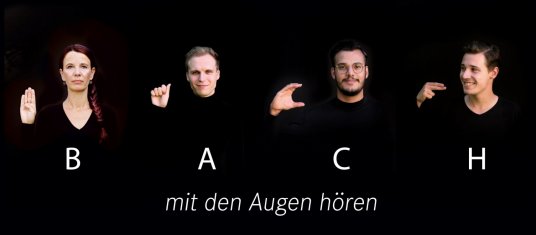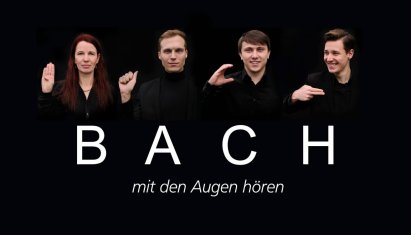|
|
SING and SIGN (Vocal & Instrumental Ensemble) |
|
Founded: 2019 - Leipzig, Saxony, Germany |
|
What and Who? |
|
J.S. Bach said: "God should be honored with all music and all music should please people."
But his music, which is an essential part of our culture, is hardly accessible to the hearing impaired. To counter this, the soprano
Susanne Haupt founded the ensemble "SING and SIGN", consisting of listening singers and hearing-impaired actors, with whom she collaborated with works by
J.S. Bach, like the Johannes-Passion (BWV 245) or some cantatas, performs audiovisually with the addition of gestures. Together with a Baroque orchestra under the musical direction of
Thomas Stadler and the pantomine director Lionel Ménard. The deaf community is supported with part of the concert revenue. |
|
How? |
|
The texts will be translated and learned in German sign language in collaboration with hearing impaired sign language interpreters and interpreters. The difficulty here is that the sign language in sentence structure and position differs from the grammar of the sung spoken language.
The polyphonic choirs are therefore signed by the singers in German grammar with the gestures of the German sign language as close to the DGS as possible. Because out of respect for this culture, the singers want to communicate directly with the sign language community in the field of music, even if they are beginners. The complex musical structure of J.S. Bachís compositions is also visualized. By using the gestures, the music should be made visible and tangible in order to give something back to those from whom they learn the language. An exchange can flow between music culture and deaf culture.
Some arias and chorals as well as the recitatives of the evangelist (reciting the narrative passages) are presented in parallel with the performance of the singers by native speakers in German sign language. On the one hand, the differences and similarities between the grammar of the spoken language and the grammar of the sign language are clearly visible, and on the other hand, the differences between the language beginners and the native speakers. The ensemble finds the moments in which singers and deaf actors to act jointly in sections particularly fulfilling. Because the idea that the singers only make music and that the hearing-impaired also sign, is for the ensemble a picture of separation and not of the connecting. |
|
For Whom? |
|
The sign language community is to be given insight into the language and culture of music through translations and visualization. In particular, access to J.S. Bachís musically challenging, complex compositions and the historical, Christian and sometimes difficult-to-understand content should be made possible. It is a mix of spoken language, DGS and DGS-related translations, which in turn corresponds to the heterogeneity of the deaf community. In purely instrumental parts, the singers visualize the parameters of the music non-verbally. Scenes and interaction with the audience are also part of the performances. So that concert visits are made as barrier-free as possible, the content is communicated on three levels: the story is interpreted by native speakers in DGS, staged and translated with DGS-related translation by the singers themselves and the text can be viewed in the program.
Listeners are supported by the visualization using gestures in the differentiated hearing of the individual voices. The audience should be given a glimpse into the language and culture of the hearing impaired, but also attention should be drawn to isolation, incomprehension and audism, i.e. discrimination against the hearing impaired, which mostly arise due to communication barriers and thus ignorance. Learning the DGS from listeners should be a step towards a smaller but special cultural community. Because the majority society should not expect from the superiority of the masses that other language and cultural communities, regardless of their nation, understand their language and adapt completely to it. |
|
Why? |
|
The intention of this project is to connect two cultures that live in one world. It is said to be a benefit for hearing and hearing impaired people, as is the case within the ensemble. A change of perspective should be encouraged for both sides, barriers and bridges built up in order to approach and exchange ideas and thereby get to know and understand each other better, to open up for each other and to focus on what connects |
|
Management Team |
|
Susanne Haupt (soprano, director, organization)
Thomas Stadler (musical director)
Elisa Otto (sign language interpreter)
Aandrea Schmetzstorff (native speaker sign soloist / translation)
Lionel Ménard (coach, director)
Naïma Märker (assistant director)
Jan-Thomas (cultural project office funding applications) |
|
Performers |
|
Susanne Haupt (Soprano, Project idea and direction, Director)
Andrea Schmetzstorff (Sign Soloist, translation)
Elisa Otto (Sign language interpreter)
Lionel Ménard (Coach, Director)
Thomas Stadler (Musical Director)
Stefan Kahle (Counter-tenor)
Robert Pohlers (Tenor)
Christoph Pfaller (Tenor)
Christopher B. Fischer (Tenor)
Anton Haupt (Bass)
Felix Rohleder (Bass) |
|
Choir |
|
Sopranos: Ines Tietze, Alicia Krähe, Ann-Kathrin Waldherr
Altos: Michaela Günold, Linda Menzer, Clemens Walter Thom, Katharina Schmidt
Tenors: Lucas Reis, Elias Riemenschneider, Marc-Eric Schmidt
Basses: Alexander Kunze, Franz Schollmeyer, Gustav Haupt, Arthur Enge |
|


|
|
Source: SING and SIGN Website
Contributed by Aryeh Oron (August 2020) |
|
Susanne Haupt : Short Biography | Ensembles: SING and SIGN
Bach Discography: Recordings of Vocal Works |
|
Links to other Sites |
|
SING and SIGNn (Official Website) [mostly German]
SING and SIGN page on Facebook |
|
|